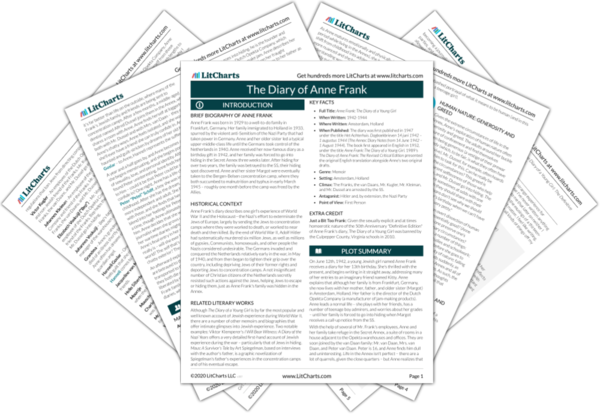Welcome to the LitCharts study guide on Anne Frank's The Diary of Anne Frank. Created by the original team behind SparkNotes, LitCharts are the world's best literature guides.
The Diary of Anne Frank: Introduction
A concise biography of Anne Frank plus historical and literary context for The Diary of Anne Frank.
The Diary of Anne Frank: Plot Summary
A quick-reference summary: The Diary of Anne Frank on a single page.
The Diary of Anne Frank: Detailed Summary & Analysis
In-depth summary and analysis of every section of The Diary of Anne Frank. Visual theme-tracking, too.
The Diary of Anne Frank: Themes
Explanations, analysis, and visualizations of The Diary of Anne Frank's themes.
The Diary of Anne Frank: Quotes
The Diary of Anne Frank's important quotes, sortable by theme, character, or section.
The Diary of Anne Frank: Characters
Description, analysis, and timelines for The Diary of Anne Frank's characters.
The Diary of Anne Frank: Symbols
Explanations of The Diary of Anne Frank's symbols, and tracking of where they appear.
The Diary of Anne Frank: Theme Wheel
An interactive data visualization of The Diary of Anne Frank's plot and themes.
Brief Biography of Anne Frank
Anne Frank was born in 1929 to a well-to-do family in Frankfurt, Germany. Her family immigrated to Holland in 1933, spurred by the violent anti-Semitism of the Nazi Party that had taken power in Germany. Anne and her older sister led a typical upper-middle-class life until the Germans took control of the Netherlands in 1940. Anne received her now-famous diary as a birthday gift in 1942, and her family was forced to go into hiding in the Secret Annex three weeks later. After hiding for over two years, the family was betrayed to the SS, their hiding spot discovered. Anne and her sister Margot were eventually taken to the Bergen-Belsen concentration camp, where they both succumbed to malnutrition and typhus in early March 1945 – roughly one month before the camp was freed by the Allies.
Get the entire The Diary of Anne Frank LitChart as a printable PDF.

Historical Context of The Diary of Anne Frank
Anne Frank's diary describes one girl's experience of World War II and the Holocaust—the Nazi's effort to exterminate the Jews of Europe, largely by sending the Jews to concentration camps where they were worked to death, or worked to near death and then killed. By the end of World War II, Adolf Hitler had systematically murdered six million Jews, as well as millions of gypsies, Communists, homosexuals, and other people the Nazis considered undesirable. The Germans invaded and conquered the Netherlands relatively early in the war, in May of 1940, and from then began to tighten their grip over the country, including depriving Jews of their former rights and deporting Jews to concentration camps. A not insignificant number of Christian citizens of the Netherlands secretly resisted such actions against the Jews, helping Jews to escape or hiding them, just as Anne Frank's family was hidden in the Annex.
Other Books Related to The Diary of Anne Frank
Although The Diary of a Young Girl is by far the most popular and well known account of Jewish experience during World War II, there are a number of other memoirs and biographies that offer intimate glimpses into Jewish experience. Two notable examples: Viktor Klemperer's I Will Bear Witness: A Diary of the Nazi Years offers a very detailed first-hand account of Jewish experience during the war – particularly that of Jews in hiding. Maus: A Survivor's Tale by Art Spiegelman, based on interviews with the author's father, is a graphic novelization of Spiegelman's father's experiences in the concentration camps and of his eventual escape.
Key Facts about The Diary of Anne Frank
- Full Title: Anne Frank: The Diary of a Young Girl
- When Written: 1942-1944
- Where Written: Amsterdam, Holland
- When Published: The diary was first published in 1947 under the title Het Achterhuis. Dagboekbrieven 14 juni 1942 – 1 augustus 1944 (The Annex: Diary Notes from 14 June 1942 – 1 August 1944). The book first appeared in English in 1952, under the title Anne Frank: The Diary of a Young Girl. 1989's The Diary of Anne Frank: The Revised Critical Edition presented the original English translation alongside Anne's two original drafts.
- Genre: Memoir
- Setting: Amsterdam, Holland
- Climax: The Franks, the van Daans, Mr. Kugler, Mr. Kleiman, and Mr. Dussel are arrested by the SS.
- Antagonist: Hitler and, by extension, the Nazi Party
- Point of View: First Person
Extra Credit for The Diary of Anne Frank
Just a Bit Too Frank: Given the sexually explicit and at times homoerotic nature of the 50th Anniversary "Definitive Edition" of Anne Frank's diary, The Diary of a Young Girl was banned by the Culpepper County, Virginia schools in 2010.












